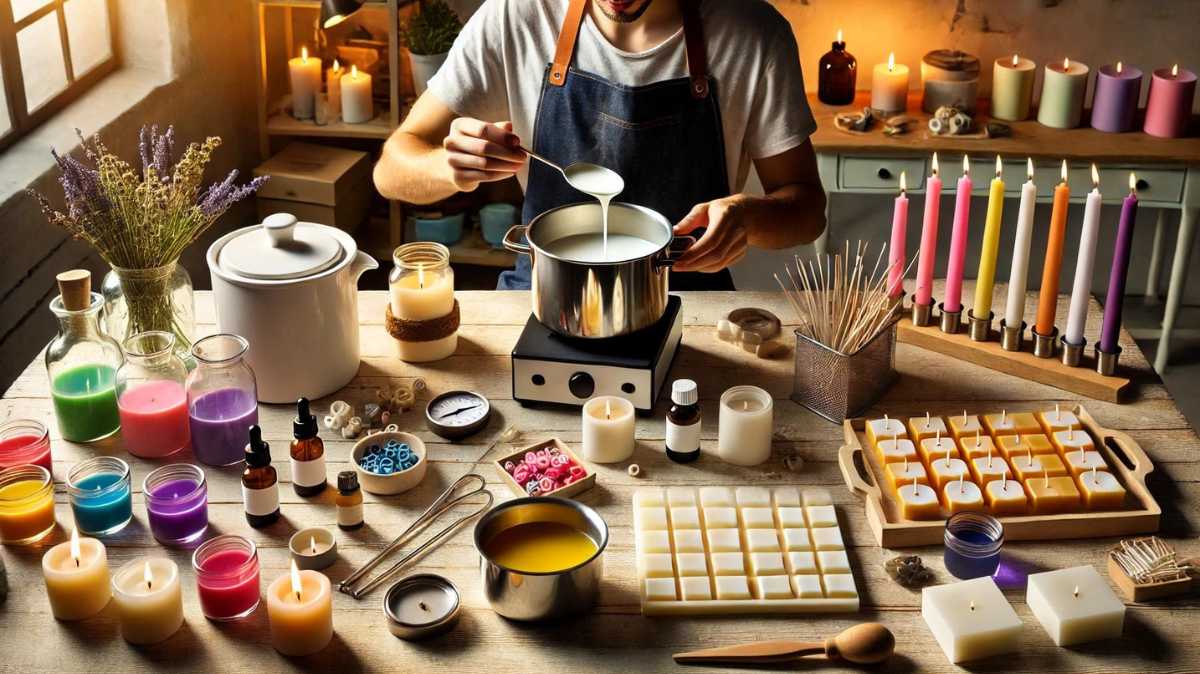Candles are more than just a source of light. They add warmth, ambiance, and a touch of personal style to any space. Whether you’re looking to save money, customize your home decor, or craft meaningful gifts, learning how to make homemade candles is an immensely rewarding and creative endeavor. And guess what? It’s much easier than you think! Let’s dig deep into the colorful, fragrant world of DIY candle-making with a step-by-step guide that will leave you glowing—pun intended.
Table of Contents
Introduction to Homemade Candle Making
So, you want to become a candle artisan? Well, you’ve come to the right place. Making homemade candles is like cooking for your soul. You mix ingredients, add a dash of creativity, and in the end, you’ve got something magical that smells wonderful and lights up your life—literally. What’s better? It’s a skill you can develop without breaking the bank or spending hours in frustration. We’re talking wax, wicks, a bit of heat, and voila—a glowing masterpiece. Plus, you’ll never have to buy candles again. Win-win, right?
Understanding Candle-Making Ingredients
To make candles that burn clean and long, you need to understand the main ingredients:
- Wax: The star of the show! Whether it’s soy, paraffin, or beeswax, each type gives your candle a unique character.
- Wick: The unsung hero. Without the wick, it’s just a fancy block of wax. Choosing the right wick ensures an even burn.
- Fragrance oils: Because no one wants a candle that smells like… wax.
- Dye: For adding a splash of color to your creation.
The relationship between these ingredients determines how well your candle burns, how long it lasts, and how good it smells.
Different Types of Wax for Candle Making
Your choice of wax is crucial. Let’s break it down:
- Paraffin Wax: The most common and budget-friendly. However, it’s petroleum-based, which isn’t the most eco-friendly choice.
- Soy Wax: Made from soybean oil, soy wax is renewable, burns clean, and holds scent well. Plus, it’s a darling of eco-conscious crafters..
- Beeswax: The oldest and most natural option. It burns longer, purifies the air, but is more expensive.
- Gel Wax: For the daring DIYer! Gel wax is translucent and can be used for embedding objects inside the candle. It burns slower but can be tricky to work with.
Choosing the right wax depends on the kind of candle you’re making and your personal preferences.
Essential Tools for Candle Making
To make your candle-making process smooth and fun, gather the following tools:
- Double boiler or a melting pot: For melting the wax without burning it.
- Thermometer: Wax has a Goldilocks temperature range; too hot or too cold, and it won’t work right.
- Stirring utensils: Preferably silicone or stainless steel, to mix your ingredients without affecting the scent.
- Candle molds or containers: The wax needs a home, whether it’s a jar, tin, or fancy mold.
- Scissors or wick trimmer: For keeping that wick in line—literally.
How to Choose the Right Wick for Your Candle
Choosing the right wick is like finding the perfect pair of shoes—it needs to fit perfectly. The wick’s size determines how the candle burns. Too thick? It’ll burn too fast and produce a lot of soot. Too thin? It’ll drown in melted wax and won’t stay lit. Here’s a rule of thumb:
- Small candles (2-3 inches): Use a small wick.
- Medium candles (3-4 inches): Go for a medium wick.
- Large candles (4+ inches): Opt for a larger wick.
Wick material also matters. Cotton is standard, but wood wicks create a delightful crackling sound, giving you that “fireplace-in-a-candle” vibe.
Step-by-Step Guide to Making Your First Homemade Candle
Now for the fun part—let’s make a candle!
Step 1: Melt the Wax
Using a double boiler or melting pot, heat your wax to the manufacturer’s recommended temperature (usually around 170°F to 180°F). Stir gently to ensure even heating.
Step 2: Prepare Your Container
While your wax is melting, fix your wick to the bottom of your container using adhesive (or a dab of melted wax). Use a wick holder or pencil across the top to keep the wick centered.
Step 3: Add Fragrance and Color
Once your wax has reached the right temperature, remove it from heat and stir in fragrance oil (typically 1 oz of fragrance per pound of wax) and any color dye you’re using.
Step 4: Pour the Wax
Pour the melted wax into your container slowly to avoid bubbles. Leave some space at the top of the container for easy trimming later.
Step 5: Let It Cool
Allow the candle to cool and harden for at least 4-5 hours. For best results, let it sit overnight.
Step 6: Trim the Wick
Once cooled, trim the wick to about ¼ inch, and your candle is ready to burn!
Adding Scents: How to Make Fragrant Candles
Want your home to smell like a French bakery or a lavender field? Here’s how:
- Fragrance oils: These are specifically made for candles and won’t affect the wax’s consistency. Fragrance oils are specifically made for candles and safe to use when handled properly. Ensure you’re familiar with safe handling of fragrance oils to avoid any irritation or adverse effects.
- Essential oils: A natural option, but be cautious—they’re more volatile and can affect the burn. Add fragrance at the right temperature (around 160°F for most waxes) to ensure it binds well with the wax.
The Art of Coloring Your Homemade Candles
Feeling bold? Add some color! Here’s how to choose the right candle dye for your project and get the most vibrant results:
- Liquid dyes: For bold, uniform colors.
- Color blocks: For subtle shades.
- Crayons: Just kidding, don’t use crayons—they’ll clog your wick.
Mix and match colors for a marbled effect, or go for layers to create a rainbow candle.
Troubleshooting Common Candle-Making Problems
Candle-making is an art, and like any craft, things can go wrong. But no worries, we’ve got solutions:
- Uneven burning: Check your wick size or placement.
- Frosting (white spots on soy candles): This is natural, but heating your container can help reduce it.
- Scent not strong enough: Make sure you’re using the right ratio of fragrance to wax.
Safety Tips When Making Candles at Home
Safety first, folks. Here’s how to keep your candle-making experience accident-free:
- Never leave melting wax unattended. It can catch fire if overheated.
- Work in a well-ventilated area. Melting wax releases fumes, so crack a window or use a fan.
- Wear protective gear. Gloves and goggles aren’t just for chemists!
Creative Ideas for Custom Candle Shapes
Basic jar candles are great, but why not get a little wild? Here are some ideas:
- Layered candles: Pour wax in different stages for cool, multi-colored layers.
- Ice candles: Place ice cubes in your mold and pour hot wax over them. The ice melts, leaving cool cratered patterns.
- Embed objects: Dried flowers, seashells, or glitter can be added to the outside of a gel candle for a truly unique design.
Eco-Friendly Candle Making: Sustainable Options
If you’re an eco-conscious candle maker, consider these alternatives:
- Soy wax: Biodegradable and sustainable.
- Cotton or hemp wicks: Organic and free of chemicals.
- Beeswax: The gold standard in natural, renewable wax options.
Packaging and Presenting Homemade Candles as Gifts
You’ve crafted the perfect candle, now it’s time to wrap it up! Use eco-friendly materials like kraft paper or reusable containers. Tie it up with a ribbon, add a personalized label, and boom—perfect gift!
FAQs: Frequently Asked Questions About Candle Making
Q1: Can I use crayons to color my candles?
A: No, crayons are made of pigment that clogs the wick. Stick to candle-safe dyes.
Q2: How much fragrance should I add to my candle?
A: A general rule is 1 oz of fragrance per pound of wax.
Q3: Why is my candle tunneling?
A: Tunneling happens when the wick is too small for the candle’s diameter. Make sure to trim your wick and choose the right size.
Q4: Can I reuse old candles?
A: Yes! Melt them down and reuse the wax for new candles.
Q5: How do I prevent air bubbles?
A: Pour your wax slowly and at the right temperature to avoid bubbles.
Q6: Why is my candle flickering?
A: A flickering flame usually indicates a wick that’s too long or a drafty room.
Conclusion: Why Homemade Candles Are the Ultimate DIY Craft
Making homemade candles is more than just a craft—it’s an experience that brings warmth, creativity, and joy. Whether you’re new to this or looking to perfect your skills, our detailed guide on how to make homemade candles walks you through every step, ensuring you create candles that are beautiful, fragrant, and uniquely yours. Ready to light up your home with your handmade creations? Start your candle-making journey today!
Author

An aspiring business leader, I am working towards my dream of graduating from Stanford University with a degree in Business Management. Passionate about sharing knowledge, I strive to empower others through education and collaborative learning.
View all posts


